|
[Front Page] [Features] [Departments] [Society Home] [Subscribe]

Paws for Reflection
Brian Walters
The Australian flora contains some of the most spectacular plants to be found anywhere...and some of the most bizarre. A few can lay claim to both descriptions.
Species in the genera Anigozanthos and Macropidia are examples. Collectively known as "Kangaroo Paws", these have not (until recently) received widespread cultivation because the more spectacular members of the group have proven to be unreliable in the garden.
In the past decade, however, a wide range of hybrids has appeared and these are introducing these unique plants to a wider audience.
Species and Hybrids
There are only eleven species of Anigozanthos and one Macropidia (M.fuliginosa, the "black kangaroo paw"). All are "grassy" clumps usually with narrow, strap-like leaves producing flowers on stems held above the foliage. In nature, they occur only in the south of Western Australia.
A.flavidus is the most commonly cultivated species and, with one or two exceptions, the others are rarely seen in gardens outside of Western Australia. The next most common species in cultivation is A.manglesii, the "red and green kangaroo paw", which is the floral emblem of Western Australia. Other particularly attractive species are A.humilis ("cat's paw), A.rufus (deep red flowers) and A.pulcherrimus (bright yellow) and these have feature prominently in hybridization work.
A.flavidus has been cultivated for many years and is almost "un-killable". It succeeds in a wide range of climates and soils, including those that are poorly drained. Unfortunately it's also the least attractive member of the genus (isn't it always the way!) In it's most common form it's a robust clump that produces tall (2 metres) flower spikes of a greenish/yellow colour.
The birds love it but it's a bit, ahh...ho hum, if you know what I mean.
There are some good colour forms of A.flavidus around but they tend to be difficult to find. Consequently, if A.flavidus was all that the kangaroo paws had to offer they would be destined to remain a curiosity. However, hybridization has changed all of that.
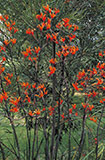 |
This red form of Anigozanthos flavidus is much more attractive in the garden than the common yellow/green form.
Select the thumbnail image or plant name for a higher resolution image (54k).
|
The aim of hybridization is to combine the reliability of A.flavidus with the beauty of some of the other 10 species. Of course, this sort of work doesn't always go to plan...producing a hybrid with the reliability of, say, A.manglesii and the beauty of A.flavidus isn't likely to improve the hybridist's sense of humour.
Some of the earliest hybridizing work was carried out in Western Australia in the 1950s but it has been since about 1970 that the greatest advances have been made. A recent issue of the journal Australian Plants (see box) listed over 80 hybrids and it's certain that more will appear in future seasons.
Selection
There are two broad groups of hybrid "paws":
- Small clumps rarely more than 300 mm high.
- Medium to large clumps with flower spikes reaching 1 - 1.5 metres (occasionally higher).
In selecting plants for general garden cultivation, the medium to large varieties are the most reliable. Most of these are in the "plant it and forget it" category. On the other hand, some of the smaller ones appear to have inherited a reasonably high fraction of their genes from the more unreliable species and, consequently, require greater attention. The smaller ones are also easily overwhelmed by nearby shrubs and are best suited to rockeries or containers.
The accompanying table lists some of the more widely available hybrids together with some of the features of each. Choosing which ones to grow is largely a matter of personal taste and the ones listed probably reflect my own bias. But, it's a reasonable selection to start with. You will probably find several others at local nurseries.
| Name | Habit | Height of
Spike
(m) | Flower
Colour | Remarks |
|---|
| Big Red | Tall | 1.5 | Bright red | Hardy and reliable |
| Bush Dawn | Tall | 1.5 | Light yellow | Very hardy; masses of flower stems |
| Bush Emerald | Small | 0.7 | Red and green | Good substitute for A.manglesii but best in a container |
| Bush Noon | Medium | 1.0 | Orange | Very spectacular and hardy |
| Bush Pearl | Small | 0.5 | Pink | Very compact; best in a container or open rockery |
| Bush Ranger | Small | 0.5 | Bright red | Spectacular; best in open position |
| Bush Sunset | Medium | 1.0 | Bright red | Hardy and reliable |
| Bush Surprise | Medium | 0.7 | Orange | Large flowers; best in open position |
| Gold Fever | Tall | 1.5 | Orange/yellow | Very vigorous; good colour |
| Red Cross | Medium | 1.0 | Burgundy | One of the best; unusual colour |
| Regal Claw | Tall | 1.5 | Red/orange | Tall spikes; large flowers |
| Yellow Gem | Tall | 1.5 | Yellow | Hardy and reliable |
|
Growing Conditions and Disease Control
Unlike A.flavidus, the hybrids are not usually tolerant of poorly drained soils. With so many hybrids available, generalizations are difficult but moisture plus reasonable drainage will suit most of the medium to large growers. They will tolerate dryness but the quality of flowering will be poor under these conditions. The smaller varieties need excellent drainage.
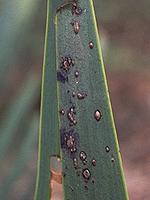 
All kangaroo paws prefer a sunny, open position. Shady or sheltered areas often allow moisture to remain on the foliage for long periods and this can promote potentially serious fungal diseases such as "inkspot" and rust. Both of these diseases can spread rapidly under humid, warm conditions and can be difficult to control.
Rust, shown left on the foliage of Macropidia fuliginosa, appears as small blisters on the leaves. These blisters break open to release dry, brown spore masses. Rust is caused by the fungus Puccinia haemodori.
Inkspot appears as black spots which gradually increase in size and is believed to be caused by the fungus Alternaria alternata. Inkspot can be a very debilitating problem as it seems to result in a breakdown in the cell structure of the leaves. Note, however, that it is not unusual for dark streaks to appear on older leaves - this is not ink spot and, provided the plant is growing vigorously, is not cause for concern.
Both diseases, particularly inkspot, are difficult to control and good cultural practice is possibly the best defense. Plants should be located in an area with good air circulation (ie. not crowded by other plants) and, as already noted, the foliage should be kept as dry as possible. This means avoiding overhead watering in hot, humid weather, particularly in the evening. Any badly infected plants should be removed.
Many of the new hybrids are being bred for resistance to these problems.
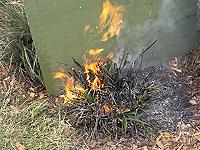 |
 |
If plants become severely infected with these diseases, an effective (but unusual) treatment is worth trying. This involves setting fire to the foliage to destroy the diseased leaves and fungal spores. It may seem a drastic form of treatment (and your neighbours may have their worst fears about you confirmed!) but the plants will quickly respond with new growth from the underground rhizome.
This is really just replicating what happens in nature. Kangaroo paws occur in heath and woodlands which are subject to periodic bushfire so, in the wild, they would be burnt back to the rhizome at regular intervals.
The accompanying photos show the rejuvenation of a hybrid kangaroo paw which had been severely attacked by ink disease. Note the barriers erected to protect nearby plants from incineration! Sufficient twigs and leaf litter were piled around the old foliage to maintain a fire for about 5 minutes.
The centre photo shows that the entire above ground parts of the plant were reduced to ash! The underground rhizome was, however, protected by the soil and, as illustrated in the lower photo, lots of clean, fresh foliage was produced by the plant over the following weeks.
|
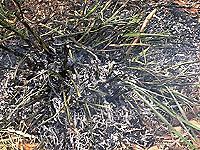
|
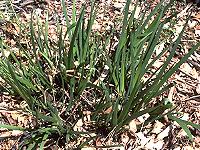 |
General Maintenance
With some of the kangaroo paws there is a tendency for the foliage to die back in summer and then to re-shoot from the underground rhizome in autumn. Some of the hybrids seem to have inherited this feature and it shouldn't be regarded as cause for concern. It may look a bit untidy for a while but there's no rule that says you can't clean up the clumps by removing the dried foliage if you find it offensive.
The dead flower spikes can also give the clumps an untidy appearance. However, kangaroo paws make excellent cut flowers so, if you cut the stems for indoor decoration, this doesn't become a problem.
It's probably best to keep the clumps to a reasonable size. Very large clumps impede air circulation and do not allow the leaves to dry rapidly after rain or watering (which may lead to disease problems).
Australian Plants
The journal Australian Plants is published quarterly by the Society for Growing Australian Plants. It features a blend of practical growing advice and scientific research information on the flora of Australia. Now in its 31st year of publication, it has received international recognition and is a credit to its editor, Bill Payne, who has been involved since the start.
The March 1991 issue was devoted entirely to the Kangaroo Paws, both species and hybrids. It is an excellent reference for anyone interested in these unusual plants.
Further information can be obtained on the Publications page.
|
| |
|
The simplest way to control the size is to divide the clumps every couple of years, usually after flowering is finished (say, January or February).
Division of large clumps of A.flavidus and the more vigorous hybrids can be fairly brutal....just put a spade through the centre of the clump, lift half of the plant out of the ground and plant it somewhere else. As long as you keep it from drying out for the following few weeks, it will be fine. You can also take very small divisions of a single shoot, together with a piece of rhizome and some roots. If these are potted up and treated like cuttings, they will quickly develop into new plants.
|
|
Kangaroo paws are an unusual feature for any garden, not just a native garden. Selecting plants when they are in flower will enable a collection to be grown that will provide flowers right through from late winter to about Christmas. They are spectacular, they can be controlled to whatever size is required and they are excellent to quickly "fill-in" bare areas.
And the honeyeaters find them irresistible!

[Front Page] [Features] [Departments] [Society Home] [Subscribe]
Australian Plants online - March 2000
Association of Societies for Growing Australian Plants
|